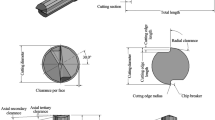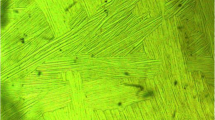Abstract
Functionally graded materials (FGMs) are a promising engineering material, which is highly desirable in extreme environments of aerospace, nuclear, and bio-implants. Although the surface accuracy and quality of 3D-printed Ni–Fe FGMs can meet most application scenarios, it still requires post-cutting treatment especially in nuclear industry. The FGMs, with the gradient of mechanical property, are a new type of difficult-to-cut material. However, no ready-made post milling process can be referred. The poor-machined surface quality induced by excessive tool wear still cannot be handled even with textured tool under minimum quantity lubrication (MQL). In this paper, the mechanical properties and machinability of the Ni–Fe FGMs as well as its 5 isotropic component 304LxIN625y were firstly studied and correlated. Then, two milling parameter selection strategies were proposed by minimum milling force and by minimum surface roughness, corresponding to strategy I and strategy II. The results show that tool breakage occurs in bottom cutting edge when strategy I is adopted. On the contrary, strategy II can reduce tool major flank wear 40.1% by forming an elastohydrodynamic lubrication between bottom cutting edge and the machined surface, which is a prospective method to solve the tool failure during milling of 3D-printed Ni–Fe FGMs.



















Similar content being viewed by others
Data availability
Not applicable.
Code availability
Not applicable.
References
Ansari M, Jabari E, Toyserkani E (2021) Opportunities and challenges in additive manufacturing of functionally graded metallic materials via powder-fed laser directed energy deposition: a review. J Mater Process Tech 294:117117. https://doi.org/10.1016/j.jmatprotec.2021.117117
Loh GH, Pei E, Harrison D, Monzón MD (2018) An overview of functionally graded additive manufacturing. Addit Manuf 23:34–44. https://doi.org/10.1016/j.addma.2018.06.023
Wang C, Zhang P, Zhang K, Wang C (2021) A novel process parameter screening strategy by comprehensively consideration of powder separation, defects and power consumption when fabricating FGM using laser metal deposition. J Clean Prod 278:123274. https://doi.org/10.1016/j.jclepro.2020.123274
Su Y, Chen B, Tan C, Song X, Feng J (2020) Influence of composition gradient variation on the microstructure and mechanical properties of 316 L/Inconel718 functionally graded material fabricated by laser additive manufacturing. J Mater Process Tech 283:116702. https://doi.org/10.1016/j.jmatprotec.2020.116702
Khan AM, Hussain G, Alkahtani M, Alzabidi A, Abidi MH, He N (2021) Holistic sustainability assessment of hybrid Al-GnP enriched nanofluids and textured-tool in machining of Ti-6Al-4V alloy. Int J Adv Manuf Tech 112:745–745. https://doi.org/10.1007/s00170-020-06436-x
Machado AR, da Silva LRR, de Souza FCR, Davis R, Pereira LC, Sales WF, de Rossi W, Ezugwu EO (2021) State of the art of tool texturing in machining. J Mater Process Tech 293:117096. https://doi.org/10.1016/j.jmatprotec.2021.117096
Darshan C, Jain S, Dogra M, Gupta MK, Mia M, Haque R (2019) Influence of dry and solid lubricant-assisted MQL cooling conditions on the machinability of Inconel 718 alloy with textured tool. Int J Adv Manuf Tech 105:1835–1849. https://doi.org/10.1007/s00170-019-04221-z
Gupta MK, Song Q, Liu Z, Singh R, Sarikaya M, Khanna N (2021) Tribological behavior of textured tools in sustainable turning of nickel based super alloy. Tribol Int 155:106775. https://doi.org/10.1016/j.triboint.2020.106775
Zhou C, Guo X, Zhang K, ChenSg L, Wu Y (2019) The coupling effect of micro-groove textures and nanofluids on cutting performance of uncoated cemented carbide tools in milling Ti-6Al-4V. J Mater Process Tech 271:36–45. https://doi.org/10.1016/j.jmatprotec.2019.03.021
Hao X, Cui W, Li L, Li H, Khan AM, He N (2018) Cutting performance of textured polycrystalline diamond tools with composite lyophilic/lyophobic wettabilities. J Mater Process Tech 260:1–8. https://doi.org/10.1016/j.jmatprotec.2018.04.049
Hao X, Chen X, Xiao S, Li L, He N (2018) Cutting performance of carbide tools with hybrid texture. Int J Adv Manuf Tech 97:3547–3556. https://doi.org/10.1007/s00170-018-2188-2
Singh R, Dureja JS, Dogra M, Randhawa JS (2019) Optimization of machining parameters under MQL turning of Ti-6Al-4V alloy with textured tool using multi-attribute decision-making methods. World J Eng 16:648–659. https://doi.org/10.1108/wje-06-2019-0170
Sivaiah P, Kumar GVA, Narasimhamu KL, Balaji NS (2022) Performance improvement of turning operation during processing of AISI 304 with novel textured tools under minimum quantity lubrication using hybrid optimization technique. Mater Manuf Process 37:693–700. https://doi.org/10.1080/10426914.2021.1967977
Sarikaya M, Gullu A (2014) Taguchi design and response surface methodology based analysis of machining parameters in CNC turning under MQL. J Clean Prod 65:604–616. https://doi.org/10.1016/j.jclepro.2013.08.040
Pratap A, Patra K (2020) Combined effects of tool surface texturing, cutting parameters and minimum quantity lubrication (MQL) pressure on micro-grinding of BK7 glass. J Manuf Process 54:374–392. https://doi.org/10.1016/j.jmapro.2020.03.024
Mishra SK, Ghosh S, Aravindan S (2020) Machining performance evaluation of Ti6Al4V alloy with laser textured tools under MQL and nano-MQL environments. J Manuf Process 53:174–189. https://doi.org/10.1016/j.jmapro.2020.02.014
An Q, Cai C, Zou F, Liang X, Chen M (2020) Tool wear and machined surface characteristics in side milling Ti6Al4V under dry and supercritical CO2 with MQL conditions. Tribol Int 151:106511. https://doi.org/10.1016/j.triboint.2020.106511
Barro Ó, Arias-González F, Lusquiños F, Comesaña R, del Val J, Riveiro A, Badaoui A, Gómez-Baño F, Pou J (2021) Improved commercially pure titanium obtained by laser directed energy deposition for dental prosthetic applications. Metals 11:70
Chen Y, Guo X, Zhang K, Guo D, Zhou C, Gai L (2019) Study on the surface quality of CFRP machined by micro-textured milling tools. J Manuf Process 37:114–123. https://doi.org/10.1016/j.jmapro.2018.11.021
Basso I, Voigt R, Rodrigues AR, Marin F, de Souza AF, de Lacalle LNL (2022) Influences of the workpiece material and the tool-surface engagement (TSE) on surface finishing when ball-end milling. J Manuf Process 75:219–231. https://doi.org/10.1016/j.jmapro.2021.12.059
Mathew KVJ (2019) Wear behavior of TiAlN coated WC tool during micro end milling of Ti-6Al-4V and analysis of surface roughness. Wear 424–425:165–182. https://doi.org/10.1016/j.wear.2019.02.018
Avegnon KLM, Schmitter DC, Meisman S, Hadidi H, Vieille B, Sealy MP (2022) Areal surface texture and tool wear analysis from machining during powder bed fusion. Procedia CIRP 108:704–709. https://doi.org/10.1016/j.procir.2022.03.109
Baumann J, Krebs E, Biermann D (2019) Chatter avoidance in milling by using advanced cutting tools with structured functional surfaces. MM Sci J 13:3019–3026. https://doi.org/10.17973/MMSJ.2019_11_2019045
Suzuki N, Takahashi W, Igeta H, Nakanomiya T (2020) Flank face texture design to suppress chatter vibration in cutting. CIRP Ann 69:93–96. https://doi.org/10.1016/j.cirp.2020.04.037
Özel T, Biermann D, Enomoto T, Mativenga P (2021) Structured and textured cutting tool surfaces for machining applications. CIRP Ann 70:495–518. https://doi.org/10.1016/j.cirp.2021.05.006
Gou J, Wang Z, Hu S, Lu WF, Shen J (2020) Microstructure evolution and mechanical properties of cold metal transfer additive manufactured Ti–6Al–4V wall with trace MoSi2 addition. Mat Sci Eng A-Struct 798:140160. https://doi.org/10.1016/j.msea.2020.140160
Weng F, Liu Y, Chew Y, Yao X, Sui S, Tan C, Ng FL, Bi G (2020). IN100 Ni-based superalloy fabricated by micro-laser aided additive manufacturing: correlation of the microstructure and fracture mechanism. Mat Sci Eng A-Struct 788: https://doi.org/10.1016/j.msea.2020.139467
An Q, Tao Z, Xu X, El Mansori M, Chen M (2020) A data-driven model for milling tool remaining useful life prediction with convolutional and stacked LSTM network. Measurement 154:107461. https://doi.org/10.1016/j.measurement.2019.107461
Fang Q, Kang ZX, Gan YW, Long Y (2015) Microstructures and mechanical properties of spark plasma sintered Cu-Cr composites prepared by mechanical milling and alloying. Mater Des 88:8–15. https://doi.org/10.1016/j.matdes.2015.08.127
Uludag M, Yazman S, Gemi L, Bakircioglu B, Erzi E, Dispinar D (2018) Relationship between machinability, microstructure, and mechanical properties of Al-7Si alloy. J Test Eval 46:2592–2603. https://doi.org/10.1520/jte20170083
Bachchhav B, Bagchi H (2021) Effect of surface roughness on friction and lubrication regimes. Mater Today: Proc 38:169–173. https://doi.org/10.1016/j.matpr.2020.06.252
Kalin M, Velkavrh I, Vižintin J (2009) The Stribeck curve and lubrication design for non-fully wetted surfaces. Wear 267:1232–1240. https://doi.org/10.1016/j.wear.2008.12.072
Zhang Y, Biboulet N, Venner C, Lubrecht A (2020) Prediction of the Stribeck curve under full-film elastohydrodynamic Lubrication. Tribol Int 149:105569. https://doi.org/10.1016/j.triboint.2019.01.028
Fang Z, Obikawa T (2017) Cooling performance of micro-texture at the tool flank face under high pressure jet coolant assistance. Precis Eng 49:41–51. https://doi.org/10.1016/j.precisioneng.2017.01.008
Funding
This work was supported by the National Natural Science Foundation of China (No. 52175429, No. 51805344, and No. 51905360) and Jiangsu Natural Science Foundation BK20221365.
Author information
Authors and Affiliations
Contributions
All the authors contributed to the study conception and design. Material preparation, data collection, and analysis were performed by Yang Ge, Jianpu Ma, Tongshun Liu, and Shu Huang. The first draft of the manuscript was written by Chengdong Wang, and the remaining authors commented on the previous version and the revised version of the manuscript. All of the authors read and approved the final manuscript.
Corresponding authors
Ethics declarations
Ethics approval
Approved.
Consent to participate
Not applicable.
Consent for publication
Not applicable.
Competing interests
The authors declare no competing interests.
Additional information
Publisher's note
Springer Nature remains neutral with regard to jurisdictional claims in published maps and institutional affiliations.
Supplementary Information
Below is the link to the electronic supplementary material.
Rights and permissions
Springer Nature or its licensor (e.g. a society or other partner) holds exclusive rights to this article under a publishing agreement with the author(s) or other rightsholder(s); author self-archiving of the accepted manuscript version of this article is solely governed by the terms of such publishing agreement and applicable law.
About this article
Cite this article
Wang, C., Ge, Y., Ma, J. et al. Effects of parameter selection strategy on tool wear when milling 3D-printed functionally graded materials with textured tool under minimum quantity lubrication. Int J Adv Manuf Technol 125, 1615–1632 (2023). https://doi.org/10.1007/s00170-022-10733-y
Received:
Accepted:
Published:
Issue Date:
DOI: https://doi.org/10.1007/s00170-022-10733-y




